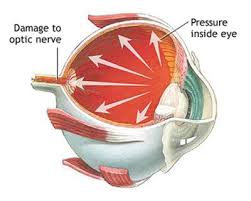What does eye pressure have to do with glaucoma?
Research shows that high eye pressure increases your risk for glaucoma. Experts believe that when the pressure inside your eye gets too high, it can damage the optic nerve and cause vision loss. And studies show that lowering eye pressure can help stop vision loss from glaucoma. That’s why it’s important to control the pressure inside your eyes.
But not everyone with high eye pressure will develop glaucoma — and some people with normal eye pressure get glaucoma. Whether you develop glaucoma depends on the amount of pressure your optic nerve can handle — and this amount is different for each person. For most people, eye pressure above 21 is higher than normal.
Getting regular dilated eye exams can help your eye doctor figure out what level of eye pressure is normal for you.
What happens when you have high eye pressure?
The pressure in your eye gets higher when fluid can’t drain normally out of the front of your eye.
Between the cornea (clear front layer of the eye) and the iris (colored part of the eye), there’s a space called the anterior chamber. Fluid normally flows through this space and out of an opening where the iris and cornea meet. The opening has spongy tissue in it, called the trabecular meshwork. The fluid passes through the meshwork to drain out of the eye.
Sometimes the trabecular meshwork blocks the fluid from draining back into the bloodstream, which increases pressure inside the eye. This pressure buildup is shown in the diagram below.
In some common types of glaucoma, fluid can’t move normally through the eye:
In open-angle glaucoma, the fluid passes too slowly through the spongy tissue in the opening where the iris and cornea meet
In angle-closure glaucoma, the opening gets blocked completely by the outer edge of the iris
In both cases, fluid builds up and increases the pressure inside the eye.
